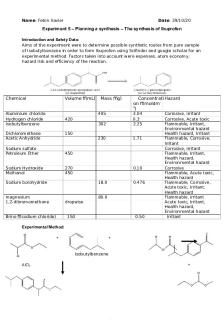Lab 1 report - Synthesis of β-Benzopinacolone: The Acid-Catalyzed Rearrangement of Benzopinacol PDF

| Title | Lab 1 report - Synthesis of β-Benzopinacolone: The Acid-Catalyzed Rearrangement of Benzopinacol |
|---|---|
| Course | Organic Chem 2 - Lab |
| Institution | Brooklyn College |
| Pages | 2 |
| File Size | 93.9 KB |
| File Type | |
| Total Downloads | 53 |
| Total Views | 148 |
Summary
Synthesis of β-Benzopinacolone: The Acid-Catalyzed Rearrangement of Benzopinacol ...
Description
Synthesis of β-Benzopinacolone: The Acid-Catalyzed Rearrangement of Benzopinacol Alesia Shalkevich Professor Lauren Bejcek
September 12, 2019 Thursday 2:05 – 5:55
Abstract: In order to examine the ability of carbocations to rearrange, this experiment was conducted converting benzopinacol to β-benzopinacolone through an acid-catalyzed rearrangement reaction. The reaction was carried out by adding 1.02 g of benzopinacol to 5mL of 0.015 M solution of glacial acetic acid with iodine as a catalyst, and heating this mixture under reflux for 5 mins. Crystal formation was observed as the solution was cooled to a room temperature. After the mixture has undergone vacuum filtration and has been rinsed with glacial acetic acid, white crystalline solid was formed. The Percent Yield was calculated to be 103.09%, which indicated incomplete dryness of the product and its possible impurity due to contamination. The melting point obtained was 184 °C, which indicated the efficient conversion of benzopinacol to β-benzopinacolone, the product of the experiment. Observations: 1. Crystals began to form at the bottom of the flask during heating. It indicated the initiation of crystallization - that the solvent could not hold all the solute molecules anymore. The solute began to form solid crystals leaving the solution. 2. Bubbles appeared when the solution was under reflux. It was an indication of the chemical reaction occurring. Bubbles were large because neither a magnetic stirring bar, nor a boiling chip was used to provide nucleating sites for them and promote smoother boiling. 3. After vacuum filtration, crystals appeared to be a mixture of white and yellow colors. In this case it was important to wash them with glacial acetic acid in excess in order to purify the product from iodine.
Results: Product Data: Melting Point of β-benzopinacolone (lit.) = 182-184 °C Theoretical Yield = 1.02g/ 366.45g/mol x 348.44g/mol = 0.97g Yield = 1.00g Melting Point of the reaction product = 184 °C % Yield = 1.00g/0.97g * 100% = 103.09%
Analysis: The % Yield of this reaction was determined to be 103.09%. This high % Yield would usually indicate the impurity of the product due to contamination. However, in this experiment, the yield of reaction could be majorly affected by incomplete dryness of the product. Since it wasn’t left to dry overnight, the product most likely has still remained solvent that was unable to evaporate before the product was weighted. The melting point determined from the product formed was 184°C. According to the literature value boiling point of β-benzopinacolone being 182-184°C, the synthesized β-benzopinacolone could be considered as relatively pure, despite the % Yield being so high. While performing this experiment, error analysis should be done towards: -
yield of the reaction obtained due to an instrumental error; presence of solvent in product solution; possible loss of product while completing steps of the experiment; purity of the product with the account to a literature boiling point; measuring melting point with the account to contaminations.
Conclusion: This experiment was a successful representation of carbocations’ ability to rearrange. In the acidic environment, where the iodine was used as catalyst, protonation of a hydroxyl group of benzopinacol has led to the creation of a carbocation. Moving from a less to a more stable state, carbocation rearrangement occurred via the steps of creating a phenonium ion as an intermediate and a phenyl group migration, forming benzopinacolone. The formation of benzopinacolone as a product was confirmed by comparing its melting point to the literature value. In order to get the more accurate % Yield, more time for the completing the experiment would be required....
Similar Free PDFs

Synthesis of Esters Lab Report
- 5 Pages

Synthesis of aspirin lab report
- 12 Pages

Lab 1 Synthesis of Acetaminophen
- 3 Pages

Lab Report 9- pinacol rearrangement
- 15 Pages

The synthesis of Ibuprofen
- 4 Pages
Popular Institutions
- Tinajero National High School - Annex
- Politeknik Caltex Riau
- Yokohama City University
- SGT University
- University of Al-Qadisiyah
- Divine Word College of Vigan
- Techniek College Rotterdam
- Universidade de Santiago
- Universiti Teknologi MARA Cawangan Johor Kampus Pasir Gudang
- Poltekkes Kemenkes Yogyakarta
- Baguio City National High School
- Colegio san marcos
- preparatoria uno
- Centro de Bachillerato Tecnológico Industrial y de Servicios No. 107
- Dalian Maritime University
- Quang Trung Secondary School
- Colegio Tecnológico en Informática
- Corporación Regional de Educación Superior
- Grupo CEDVA
- Dar Al Uloom University
- Centro de Estudios Preuniversitarios de la Universidad Nacional de Ingeniería
- 上智大学
- Aakash International School, Nuna Majara
- San Felipe Neri Catholic School
- Kang Chiao International School - New Taipei City
- Misamis Occidental National High School
- Institución Educativa Escuela Normal Juan Ladrilleros
- Kolehiyo ng Pantukan
- Batanes State College
- Instituto Continental
- Sekolah Menengah Kejuruan Kesehatan Kaltara (Tarakan)
- Colegio de La Inmaculada Concepcion - Cebu










